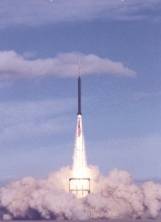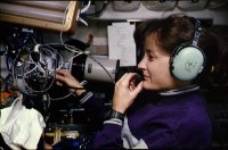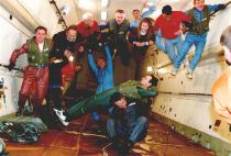| HobbySpace Home | Space Gazette | Space Activism |
Space Fun for Everyone
A brief survey of space
hobbies and activities
By Clark S. Lindsey
Reprint of article in Ad
Astra Magazine - National Space Society - May/June 2002
under the title Unconventional Space: Amateur Spacers?
In the future, amateur space enthusiasts will place satellites into orbit and communicate with them from garage ground stations. They will launch high altitude rockets and design passenger carrying sub-orbital vehicles. They will buy tourist trips to the Space Station. They will direct spacecraft orbiting other planets and participate in the scientific exploration of our solar system. They will create wonderful works of art and music inspired by space exploration.
The Future Is Now!!
Today's space enthusiasts, in fact, participate right now in not only these exciting space activities but in many others as well. Regardless of age, education, or location, you can find all kinds of great "space stuff" to do.
I'm speaking here, in particular, about hobbies and activities that directly involve, or are inspired by, humanity's exploration and development of space. So while astronomy is, of course, the original space hobby, observing low orbiting spacecraft, such as the Space Station, by telescope or the unaided eye, is a new and exciting variation.

Figure 1 George Garboden and members of the Reaction
Research Society amateur rocketry club
built this 500lb rocket that launched a payload to 53mi on Nov. 23, 1996.
Amateurs led the way to space during the early decades of the 20th century when government funding was nearly non-existent. Organized in rocket and space societies, they built and launched rockets as well as helped develop the theory and techniques of space flight.
The huge and expensive government space programs of the post war period, though, led to the common impression that there was nothing about space with which the general public could relate. But beneath the media radar, amateur space enthusiasts continued to find new and fun ways to participate in space development and exploration.
Homebuilts in Orbit
The most impressive examples of amateur accomplishments in space are the AMSAT satellites. The first amateur satellite, OSCAR 1, was launched in 1961, just four years after Sputnik 1. Over 30 amateur satellites have since reached orbit. The AMSAT program originated in the Ham radio community and includes chapters around the world.
Working in basements and garages, volunteers built most of the AMSAT orbiters, usually with equipment donated for free. Though small and cheap, the satellites have made significant contributions to space technology. For example, they were the first to demonstrate the "piggyback" technique in which a small satellite gets a free ride on the launch of a major payload in place of ballast. They also pioneered techniques for digital store-and-forward messaging and Doppler location techniques for search and rescue.
Furthermore, the amateur spacecrafts demonstrated the serious capabilities of small satellites when it was generally believed that only large satellites could provide significant services. Today there are numerous "small-sat" projects, especially at universities, that follow the AMSAT low cost model.

Figure
2 Onboard the Space Shuttle Endeavour, astronaut Linda M. Godwin
uses the Shuttle Amateur Radio Experiment (SAREX) to communicate with
hams and students on Earth. (NASA JSC Digital Image Collection.)
Radio Space Hams also carry out a number of other space activities such as communicating with astronauts and cosmonauts in orbit. A Ham radio station recently opened for business on the Space Station.
You don't need a Ham license, though, to receive spacecraft transmissions. For example, a fun hobby is to download images directly from weather and remote sensing satellites. For a modest investment in a suitable short-wave receiver, an antenna and some software, you can convert your PC into a satellite ground station.
Yes, I know. You can download satellite images directly off the web. But it's just not the same!
With your tracking program you watch your target satellite, typically a NOAA polar orbiter, approach your location. You listen to your receiver while wondering if you've downloaded the right orbital parameters from NORAD and if the receiver is properly tuned.
Sure enough, just when the satellite was predicted to rise above the horizon you hear its signature tick-tock sound. You rush frantically to start the program that uses the sound card to decode the signal. Soon you see the picture unfolding one pixel line at a time as the satellite swings its camera back and forth across its ground path.
It's sure a lot more fun than visiting the CNN weather page! Tracking and scanning of satellites brings a wonderful feeling of interaction and involvement with the great space infrastructure around us.
Amateur Rocketry Goes Big Time
Traditional model rocketry developed in the 1950s with an emphasis on teaching young people about rockets and science. The rockets were small and used very safe, factory built motors. Today the rockets are still very safe but they have grown into big adult toys.
High power rocketry enthusiasts now build rockets meters in length and launch them to thousands of meters in altitude. In fact, when clubs meet for launchings they need high altitude waivers from the FAA to avoid interfering with passing aircraft!
Some advanced rocketry clubs go the next step and build custom rockets to attack amateur high altitude records. The Reaction Research Society built a 2-stage vehicle that sent in 1996 a payload over 50 miles high, the official US boundary of space.
While amateurs are not quite within reach of building passenger rockets, they can contribute to the cause. About twenty teams have registered for the X-Prize competition to build a reusable sub-orbital crewed vehicle. Several of these groups welcome help from skilled amateurs willing to volunteer their talents and labor.
A Piece of Space History
Just as there are history buffs obsessed with the American Civil War or the Wild West period, there are those who immerse themselves in space history. The great number of personal web sites devoted to space history attests to the intense interest it inspires. Some sites are vast encyclopedias of general space historical information, while others concentrate on a single topic such as the lunar landing module.
Collecting a bit of space history has also become a popular, and potentially lucrative, hobby. Space collectibles range from mission patches to stamps and covers to autographs of astronauts and cosmonauts to space toys to anything actually flown in space. Even the famous Christie's has held several space memorabilia auctions.
The ultimate space collectible is a piece of the moon. US law forbids private possession of lunar material collected by the Apollo astronauts but incidental dust found on surplus items is permitted. For example, the astronauts were allowed to keep the nametags from their spacesuits. It was only discovered later that the tags from the Moon walkers' suits were impregnated with dust. A nametag from Jim Irwin's Apollo 15 suit was bought at a Christie's auction in 1999 for $310,500!
Creative Space
Collecting space art is growing in popularity as well. Original works by famous artists such as Chesley Bonestell and Robert McCall draw premium prices. Astronaut turned artist, Alan Bean adds a bonus to his paintings - he mixes a bit of moon dust from his nametag into the paint.
Amateur artists also create wonderful space art and many present their work on the web. Space art contests are helping to raise the visibility of this marvelous pursuit, especially with young people. For example, the ESA Envisat remote sensing satellite will carry selected student drawings and paintings of their vision of a flag to represent earth.
Music is another creative pursuit where enthusiasts make their own space inspired compositions. There have been space music contests, as well, sponsored by groups like the NSS and the Mars Society.
Amateur Space Research
In astronomy, amateurs have long made serious contributions. For example, they are often the first to spot previously unknown comets and asteroids.
In space science, as well, there are now opportunities for amateur participation. JPL and the Planetary Society, for example, recently arranged for several students, winners of an essay competition, to direct the cameras on the Mars Global Surveyor and analyze the images. There will be similar projects to control future rovers on Mars.
Most NASA and ESA projects now include outreach efforts to involve students and the general public. One online NASA project, for example, allows public participants to help mark and classify craters on Mars.
The Mars Society has established a prototype Mars base on Devon Island in the Canadian Arctic where the environment is about as close to Mars as can be found on earth. Volunteers spent the summer of 2000 assembling the habitat and new volunteer teams will return each summer to develop technology and techniques for human exploration of Mars.

Incredible
Adventures
Figure 3 Book a ride on a
Russian zero-g simulator. The Russian IL-76 MDK flies
a series of parabolic trajectories to simulate zero gravity for its occupants.
The weightless periods last for approximately 25 seconds each.
Let's Go!
There are many other such hobbies and activities that involve us with space such as rocket and spacecraft scale modeling, development of hardware and software space simulators, downloading spy satellite images of our cities, the SETI@Home project, and more.
Even space tourism is on the verge of becoming a reality. Dennis Tito, a space enthusiast since childhood, has gained great attention with his $20 million quest for a week in space. Other citizen explorers have paid to ride a cosmonaut training airplane that flies a parabolic path to create periods of weightlessness. A US company has taken a number of reservations for a vehicle that will provide sub-orbital rides to 100km by the end of this decade.
We do these things not
because they are easy,
but because they are fun!
For too long the public has viewed space as a spectator sport played entirely by members of a distant and remote government-industrial complex. It's time to get out the word that regular folk can do space stuff.
An interest in space can go beyond watching videos of the astronauts on the shuttle or gazing at sci-fi renderings of what might be "someday". You can actually do something yourself that is fun and captivating and, moreover, brings a real sense of participation in humanity's great space adventure.
© 2002 by Clark S. Lindsey
Note:
This article was submitted in March 2001 but not
included in Ad Astra till the May/June 2002 issue. This
is the reason some of the remarks, e.g. about Tito
and Devon Island, are out of date.
| HobbySpace Home | Space Gazette | Space Activism |